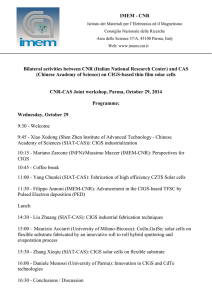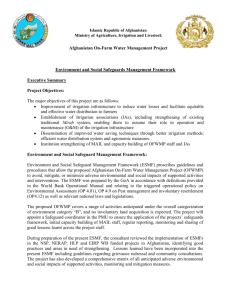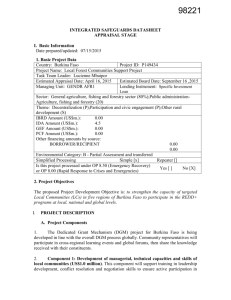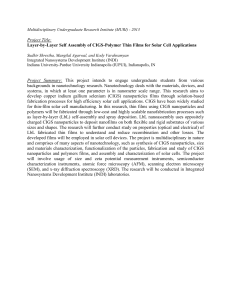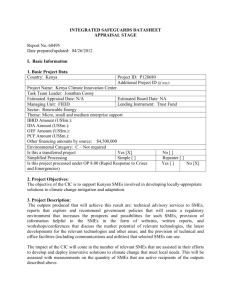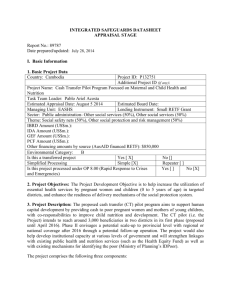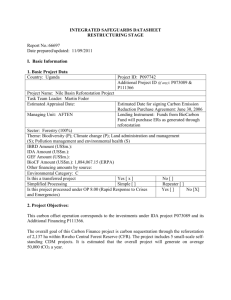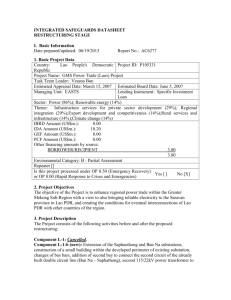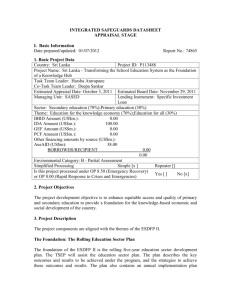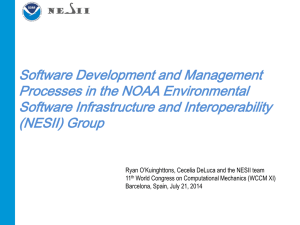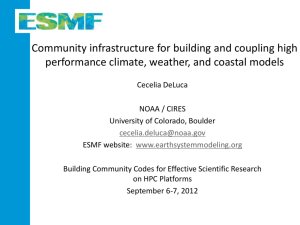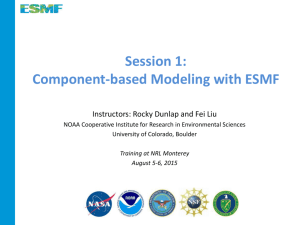INTEGRATED SAFEGUARDS DATASHEET
advertisement
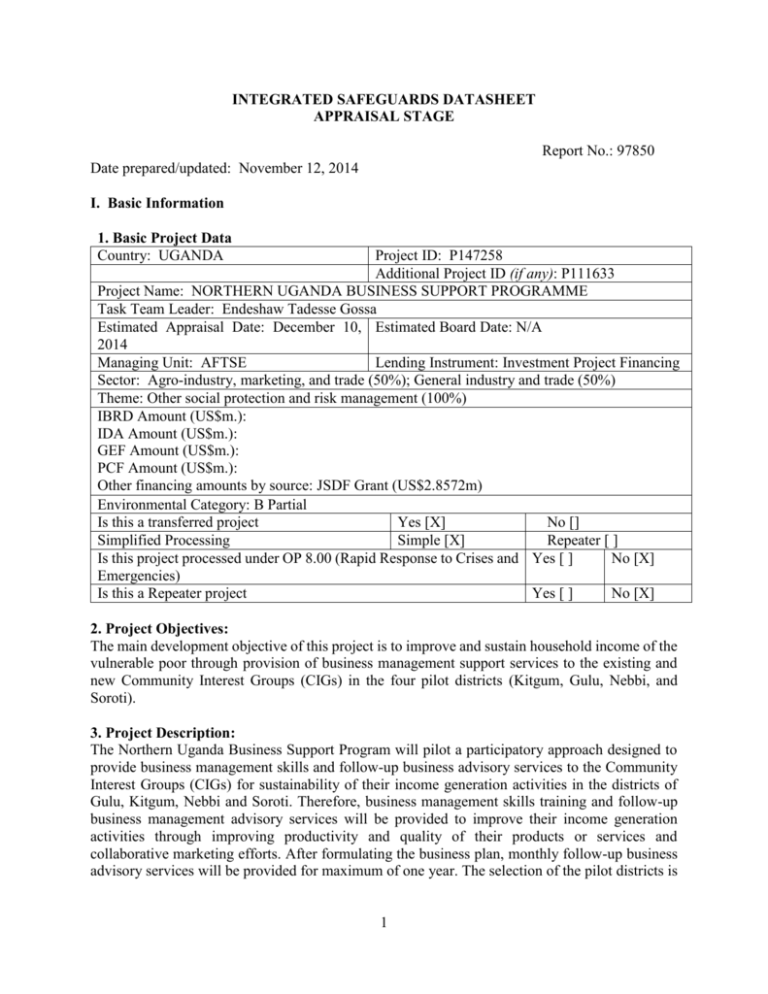
INTEGRATED SAFEGUARDS DATASHEET APPRAISAL STAGE Report No.: 97850 Date prepared/updated: November 12, 2014 I. Basic Information 1. Basic Project Data Country: UGANDA Project ID: P147258 Additional Project ID (if any): P111633 Project Name: NORTHERN UGANDA BUSINESS SUPPORT PROGRAMME Task Team Leader: Endeshaw Tadesse Gossa Estimated Appraisal Date: December 10, Estimated Board Date: N/A 2014 Managing Unit: AFTSE Lending Instrument: Investment Project Financing Sector: Agro-industry, marketing, and trade (50%); General industry and trade (50%) Theme: Other social protection and risk management (100%) IBRD Amount (US$m.): IDA Amount (US$m.): GEF Amount (US$m.): PCF Amount (US$m.): Other financing amounts by source: JSDF Grant (US$2.8572m) Environmental Category: B Partial Is this a transferred project Yes [X] No [] Simplified Processing Simple [X] Repeater [ ] Is this project processed under OP 8.00 (Rapid Response to Crises and Yes [ ] No [X] Emergencies) Is this a Repeater project Yes [ ] No [X] 2. Project Objectives: The main development objective of this project is to improve and sustain household income of the vulnerable poor through provision of business management support services to the existing and new Community Interest Groups (CIGs) in the four pilot districts (Kitgum, Gulu, Nebbi, and Soroti). 3. Project Description: The Northern Uganda Business Support Program will pilot a participatory approach designed to provide business management skills and follow-up business advisory services to the Community Interest Groups (CIGs) for sustainability of their income generation activities in the districts of Gulu, Kitgum, Nebbi and Soroti. Therefore, business management skills training and follow-up business management advisory services will be provided to improve their income generation activities through improving productivity and quality of their products or services and collaborative marketing efforts. After formulating the business plan, monthly follow-up business advisory services will be provided for maximum of one year. The selection of the pilot districts is 1 based on poverty map of the Northern Uganda, the choice of a wide range of income generation activities and accountability status of NUSAF2 disbursed funds by the districts. Details on project components are provided below: Component 1: Providing business training, small grants and follow-up business advisory services to CIGs (US$2,271,000) This component will support the formation, training, provision of small grant and business followup services to 240 new CIGs. It will also provide training and business follow-up services to existing 120 CIGS. The existing CIGs will not receive small grants because they must have already received similar grants from NUSAF 2 project. The new CIGs will be formed by individuals from poor households (10 to 15 individuals per CIG) following the NUSAF 2 participatory process. The rationale for the formation of new CIGs stems from the fact that the majority (over 85%) of the existing CIGs are focused on traditional based activities for income generation, such as cattle and goat rearing, which take a relatively long time to generate income. It is envisaged that the new CIGs will be guided during the enterprise identification process to focus on value addition and services based activities which have potential to generate higher income in a relatively short time. This will also help to widen the choice of income generation activities by the poor communities. This component will have five activities: (i) Formation of new CIGs and identification of possible income generation activities focusing on value addition or service activities based on local market assessment; (ii) providing business management training both to new and existing CIGs and assisting them to produce business plans; (iii) providing small grants to new CIGs for starting their income generating activities; (iv) establishing mentor support system; and (v) providing business advisory services. The details of the activities are presented below. Component 2: Program Management and Administration, Monitoring and Evaluation, and Knowledge Dissemination (US$586,000) This component will finance three activities: (i) Program management and administration; (ii) Monitoring and Evaluation; and (iii) Knowledge dissemination. In order to ensure good program management, and governance and accountability, including financial management within the central program implementation office, the program implementing districts and the associated partners, this component will provide financing for basic grant administration and monitoring and evaluation. It will also help ensure that lessons from the work are properly shared through a knowledge dissemination sub-component. 4. Project Location and salient physical characteristics relevant to the safeguard analysis: 2 The NUBUSP will provide support to the vulnerable poor, who are located in communities of four districts in the Northern and Eastern Regions: (i) Kitgum District; (ii); Gulu District; (iii) Nebbi District; and (iv) Soroti District. By its nature the project is likely to have minimal or no adverse environmental and social impacts and therefore given EA category B partial. With specific reference to Component 2 involving provision of small grants to new CIGs, the sub projects to be supported for value addition may generate minimal impacts, which can be addressed by use of the existing Environment and Social Management Framework (ESMF) and Resettlement Policy Framework (RPF) used in the NUSAF2 sub-projects (P111633). This project will follow the existing model used in NUSAF2 project for administering sub grants. Therefore, the ESMF and RPF for NUSAF2 project will be used to address any environmental and social impacts that may be associated with NUBUSP. The framework approach has been recommended for use because the exact project activities that may be supported under components 1 will be selected during implementation. The ESMF provides a screening process for sub-projects so as to enable local government staff to identify potential environmental and social impacts of sub-projects and to address them by incorporating the relevant mitigation measures into the designs of the sub-projects. The RPF on the other hand provide guidance on how to handle any arising compensation and social issues. Enterprise based Training will be provided to CIGs when they are completing the environment section of their application forms for the grant by the District Environment Officer and Community Development Officer, or by hired service providers. 5. Environmental and Social Safeguards Specialists on the Team: Herbert Oule - (GENDR) - Environmental Specialist Constance Nekessa-Ouma - (GURDR)- Social Development Specialist 3 6. Safeguard Policies Triggered Explanation (Optional) Yes The proposed project is focused on improvement of value Environmental addition and service delivery in relation to the ongoing Assessment (OP/BP 4.01) NUSAF2 World Bank funded project. By its nature the project is likely to have minimal or no adverse impacts and therefore given EA category B. Under component 1 the project is envisaged to support income generating activities, and depending on their nature and scale, the activities may have limited and localized environmental and social impacts that need to be identified and mitigated. The existing Environment and Social Management Framework (ESMF), which is applied to NUSAF2 (P111633) Project will be used. The NUSAF2 ESMF is used since it provides the guidelines that GoU is currently using for sub-projects involving districts, local government and villages in Northern Uganda including among others Kitgum, Gulu, Nebbi and Soroti Districts. Where necessary, ESMPs shall be developed during implementation to guide specific project activities under component 1. Projects/activities that may negatively affect any Natural Habitats (OP/BP No ecosystem will not be supported under this project. 4.04) No The project shall not support activities that will negatively Forests (OP/BP 4.36) affect any forest ecosystem. Yes Pest Management has been triggered because there is Pest Management (OP likely to be small scale use of pesticides that may be 4.09) applied for veterinary care of animals under component 2 Business Support for Income Generation activities. The NUSAF 2 ESMF adopted to use in this project has guidance on the use and management of pesticides that shall be applied. No The project activities shall not be undertaken in areas with Physical Cultural PCRs nor will it involve major civil/earth works. Resources (OP/BP 4.11) No There are no indigenous people in the four pilot districts Indigenous Peoples (Kitgum, Gulu, Nebbi, and Soroti). (OP/BP 4.10) Yes The project is focusing on value addition and service Involuntary delivery. The project will focus on supporting family Resettlement (OP/BP income through value additions and business planning and 4.12) management and will endeavor to exclude activities that require involuntary resettlement. However, in case of any involuntary resettlement issues, the RPF for NUSAF 2 shall be applied since NUBUSP is meant to augment it. No No large scale dam (irrigation) related activities are Safety of Dams (OP/BP envisaged under this project. 4.37) The project will not support activities that involve use of Projects on International No International Waterways. Waterways (OP/BP 7.50) 4 Projects in Disputed Areas (OP/BP 7.60) No The project will not be implemented in disputed areas. II. Key Safeguard Policy Issues and Their Management A. Summary of Key Safeguard Issues 1. Describe any safeguard issues and impacts associated with the proposed project. Identify and describe any potential large scale, significant and/or irreversible impacts: The project is to fund income generation activities such as poultry keeping, piggery, tree nursery, juice packing (tamarind, pineapple, passion fruits), honey making, packaging rice, groundnuts paste, vegetables gardening (tomato, onion, cabbage, eggplant, green gram, cowpea, beans), sesame oil processing (simsim), bakery, fruit processing (sun dry), milk processing (Bongo), poultry with local chicken (Akokorei), aquaculture, smoke fish, maize flour, Chapati (made of cassava flour), mushroom gardening, salon, tailoring, etc.. The project is largely small scale and is likely to have minimal environmental and social impact. It is anticipated that juice packing, groundnuts paste, sesame oil processing, fruit processing will lead to the discharge of small amounts of waste into environment. Most of the waste/remains associated with the various food processes, can be recycled or re-used, especially for animal feeds and fertilizers. However, it can be said that the negative environmental impacts anticipated from the project within the ESMF is minimal and will be managed accordingly. 2. Describe any potential indirect and/or long term impacts due to anticipated future activities in the project area: None anticipated 3. Describe any project alternatives (if relevant) considered to help avoid or minimize adverse impacts: Not relevant. 4. Describe measures taken by the borrower to address safeguard policy issues. Provide an assessment of borrower capacity to plan and implement the measures described: NUSAF2 has already prepared ESMF and RPF, which were disclosed and will be used for the JSDF/NUBUSP Project. NUSAF2 is already implementing a similar/same type of project and is quite familiar with safeguard policy issues and mitigation plans. NUSAF2 ESMF outlines the principles, the institutional arrangements and identifies the potential negative environmental impacts. The ESMF also include management plans for addressing the potential negative impacts, which have been classified as minimal and reversible. There is also capacity building arrangements for relevant staff of the project team and implementing entities to ensure full comprehension prior to and during project implementation. NUSAF2 prepared ESMF since the specific locations of activities that would have such impacts were not known at the time of appraisal. The NUSAF2 ESMF and RPF will be disclosed both in-country and Infoshop for application to Northern Uganda Business program. During implementation when these sites have been identified and agreed on, 5 screening will be undertaken and follow up management plans will be elaborated using the outlined one in the ESMF to address specific issues. The implementation of the ESMF requirements shall be led by the Environmental Specialist, assisted by the respective District Environment and Community Development Officers, all of whom are in place, have been trained and will be actively involved. 5. Identify the key stakeholders and describe the mechanisms for consultation and disclosure on safeguard policies, with an emphasis on potentially affected people: The key stakeholders are Community Interest Groups (CIGs) and NGOs operating in these areas, the respective District and Lower Local Governments, the Private Sector, etc. The NUSAF2 has identified these key stakeholders and established the mechanism for consultation and disclosure on safeguard policies, with an emphasis on potentially affected people. B. Disclosure Requirements Date Environmental Assessment/Audit/Management Plan/Other: Was the document disclosed prior to appraisal? Yes Date of receipt by the Bank 12/17/2008 Date of "in-country" disclosure 12/15/2008 Date of submission to InfoShop 12/24/2008 For category A projects, date of distributing the Executive Summary N/A of the EA to the Executive Directors Resettlement Action Plan/Framework/Policy Process: Was the document disclosed prior to appraisal? Yes Date of receipt by the Bank 12/17/2008 Date of "in-country" disclosure 12/15/2008 Date of submission to InfoShop 12/24/2008 Indigenous Peoples Plan/Planning Framework: Was the document disclosed prior to appraisal? N/A Date of receipt by the Bank Date of "in-country" disclosure Date of submission to InfoShop Pest Management Plan: Was the document disclosed prior to appraisal? N/A Date of receipt by the Bank Date of "in-country" disclosure Date of submission to InfoShop * If the project triggers the Pest Management and/or Physical Cultural Resources policies, the respective issues are to be addressed and disclosed as part of the Environmental Assessment/Audit/or ESMP. If in-country disclosure of any of the above documents is not expected, please explain why: C. Compliance Monitoring Indicators at the Corporate Level (to be filled in when the ISDS is finalized by the project decision meeting) OP/BP 4.01 - Environment Assessment 6 Does the project require a stand-alone EA (including ESMP) report? If yes, then did the Regional Environment Unit or Sector Manager (SM) review and approve the EA report? Are the cost and the accountabilities for the ESMP incorporated in the credit/loan? OP/BP 4.04 - Natural Habitats Would the project result in any significant conversion or degradation of critical natural habitats? If the project would result in significant conversion or degradation of other (non-critical) natural habitats, does the project include mitigation measures acceptable to the Bank? OP 4.09 - Pest Management Does the EA adequately address the pest management issues? Is a separate PMP required? If yes, has the PMP been reviewed and approved by a safeguards specialist or Sector Manager? Are PMP requirements included in project design? If yes, does the project team include a Pest Management Specialist? OP/BP 4.11 – Physical Cultural Resources Does the EA include adequate measures related to cultural property? Does the credit/loan incorporate mechanisms to mitigate the potential adverse impacts on physical cultural resources? OP/BP 4.10 - Indigenous Peoples Has a separate Indigenous Peoples Plan/Planning Framework (as appropriate) been prepared in consultation with affected Indigenous Peoples? If yes, then did the Regional unit responsible for safeguards or Sector Manager review the plan? If the whole project is designed to benefit IP, has the design been reviewed and approved by the Regional Social Development Unit? OP/BP 4.12 - Involuntary Resettlement Has a resettlement plan/abbreviated plan/policy framework/process framework (as appropriate) been prepared? If yes, then did the Regional unit responsible for safeguards or Sector Manager review and approve the plan/policy framework/process framework? OP/BP 4.36 – Forests Has the sector-wide analysis of policy and institutional issues and constraints been carried out? 7 Yes [ ] No [X] N/A [ ] No [ x ] N/A [ ] No [ ] N/A [] Yes Yes [ ] Yes [ X] Yes [ ] N/A No [ X ] N/A [X] Yes [ ] No [ ] N/A [X] Yes [ ] No [ ] N/A [X] Yes [ X] No [ ] N/A [] Yes [ X] No [ ] N/A [] Yes [ ] No [ ] N/A [ X ] Does the project design include satisfactory measures to overcome these constraints? Does the project finance commercial harvesting, and if so, does it include provisions for certification system? OP/BP 4.37 - Safety of Dams Have dam safety plans been prepared? Yes [ ] Have the TORs as well as composition for the independent Panel of Experts (POE) been reviewed and approved by the Bank? Has an Emergency Preparedness Plan (EPP) been prepared and arrangements been made for public awareness and training? OP/BP 7.50 - Projects on International Waterways Have the other riparian been notified of the project? Yes [ ] If the project falls under one of the exceptions to the notification requirement, has this been cleared with the Legal Department, and the memo to the RVP prepared and sent? What are the reasons for the exception? Please explain: Has the RVP approved such an exception? OP/BP 7.60 - Projects in Disputed Areas Has the memo conveying all pertinent information on the international aspects of the project, including the procedures to be followed, and the recommendations for dealing with the issue, been prepared Does the PAD/MOP include the standard disclaimer referred to in the OP? The World Bank Policy on Disclosure of Information Have relevant safeguard policies documents, Appraisal ISDS & NUSAF-2 ESMF, been sent to the World Bank's Infoshop? Have relevant documents been disclosed in-country in a public place in a form and language that are understandable and accessible to project-affected groups and local NGOs? All Safeguard Policies Have satisfactory calendar, budget and clear institutional responsibilities been prepared for the implementation of measures related to safeguard policies? Have costs related to safeguard policy measures been included in the project cost? Does the Monitoring and Evaluation system of the project include the monitoring of safeguard impacts and measures related to safeguard policies? 8 Yes [ ] Yes [X] No [ ] N/A [ X ] No [ ] N/A [ X ] No [ ] N/A [ X ] No [ ] N/A [ ] Yes [X] No [ ] N/A [ ] Yes [X] No [ ] N/A [ ] Yes Have satisfactory implementation arrangements been Yes [X] agreed with the borrower and the same been adequately reflected in the project legal documents? No [ ] N/A [ ] D. Approvals Signed and submitted by: Task Team Leader: Approved by: Regional Safeguards Coordinator: Comments: Name Endashaw Tadesse Gossa Date Nov 12, 2014 Alexandra C. Bezeredi Dec. 8, 2014 Sector Manager: Comments: Manuel Salazar Dec. 8, 2014 9
